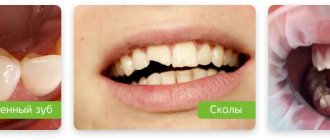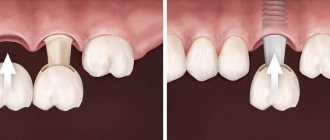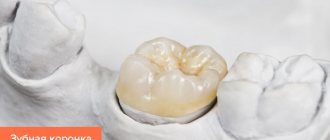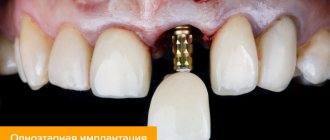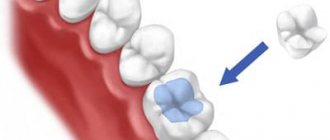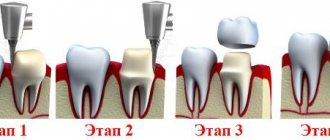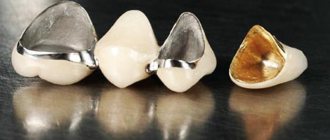Installing a crown on a tooth is one of the prosthetic options used when one or more dental units in a row are lost. Sometimes a dental crown is required even in the absence of a single edentia - for example, if it is necessary to restore the aesthetics of the dentition in the smile area. There are specific indications and contraindications for the procedure, and it is performed in several stages. We will discuss the specifics of the process of installing dental crowns in detail below.
After reading the material, you can find out how to install a crown on a tooth, what types of structures can be used in the procedure, and whether the process will be painful for the patient. We will also separately consider the specifics of removing a dental crown.
Calculate the cost of treatment by taking a short test in 20 seconds!
Do not delay your treatment, because in this matter time plays against us.
Prices at Doctor Zhuravlev Clinic
| Plastic crown (temporary) | PC. | 1000 rub. |
| Solid crown | PC. | 3600 rub. |
| Metal-ceramic crown | PC. | 6000 rub. |
| Metal-ceramic crown on an implant | PC. | 15,000 rub. |
| Zirconium oxide crown for implant | PC. | 16,000 rub. |
| Crown based on zirconium oxide | PC. | 13000 rub. |
| Endocrown | PC. | 12000 rub. |
| Pressed ceramic crown | PC. | 14,000 rub. |
| Stump tab | PC. | 3600 rub. |
Crown on a tooth
When the crown part of a tooth is severely damaged and its restoration may not be effective, even if a light-hardening gel filling is used, it makes sense to install a crown on the tooth. This will help keep it from being removed, which is especially important when good, undamaged roots remain. Modern dental treatment technologies make it possible to reach the canals of a pulpless tooth, completely disinfect them and seal them so that inflammatory processes in the gums cannot develop in the future. This guarantees a long service life of the dental crown.
Indications for crown installation
- A severely damaged tooth, more than 50%
, when a filling cannot restore it. The cause is most often advanced caries; - large chip due to injury. In this case, the root is intact. It is enough to put a crown on top to restore integrity;
- fluorosis A disease that manifests itself as stains on teeth that cannot be whitened. Appear from an excess of fluoride in the body;
- aesthetic restoration, in case of defects: curvatures, altered shape, dissatisfaction with the color of the enamel.
What is a tooth crown: a little history
Strengthening teeth with crowns has been known for a long time, but previously they were made exclusively from metals, which often caused allergies and could lead to gum ulceration. The situation was aggravated by the fact that at that time there were no gel fillings, which in most cases could replace a crown. Therefore, it was necessary to resort to orthodontic care even with relatively small chips on the teeth. A modern dental crown looks just like a real tooth, and its color can be matched strictly to the shade of the patient’s tooth enamel. Indications for the installation of dental crowns have also been revised over time.
For example, previously crowns were used to mask chips. But if a metal crown is visible in the dentition, then the benefit of such “disguise” seems relative. Such a crown is more convenient to chew than a chipped tooth, the tooth underneath is protected from the formation of caries, but in terms of aesthetic parameters it does not stand up to criticism. Today, a small chip can be repaired with a filling, but a crown can now be installed on a pin or stump, even when the upper part of the tooth is completely destroyed.
What is a dental crown in prosthetics? This is the part of the bridge or clasp prosthesis that is put on the supporting teeth. Artificial teeth are attached to such crowns by one method or another, filling the row. Many people are afraid of bridge or clasp prosthetics because they do not know which teeth can be crowned and which cannot. At the same time, not everyone is a candidate for implantation, so we need to clarify the possibilities of modern dentistry.
Which teeth are crowns placed on during prosthetics?
Today, the question “which teeth are crowned on” refers less to their location on the upper or lower jaw, but to the condition of the teeth themselves. If you need to remove the defect of only one tooth, on which a crown is installed for this purpose, then its condition can be initially any. But before it comes to making a crown, the tooth requires basic treatment. If a patient develops processes such as periodontitis, then first the doctor must go through all the canals and seal them using gutta-percha pins and filling material. The quality of root filling should be checked using an x-ray. If a cyst is found near the roots, then this is not always a reason to remove the tooth, but it requires longer treatment, the prescription of antibiotics and other drugs that help restore damaged soft tissue.
If the visible part of the tooth is completely destroyed, then the crown can be installed on the root using a dental inlay. If it comes down to tooth extraction, and the person agrees to implantation, then in this case, too, a crown is used, which “crowns” the implant, imitating the visible part of the tooth. But where to put the crowns, on the upper and lower teeth, it doesn’t matter. Even if it is necessary to properly heal wisdom teeth that a person chews normally, dental crowns can be installed.
What materials are used to make modern crowns?
Today, most materials for crowns are the color of natural tooth enamel, and metal crowns can still be installed only in the depths of the mouth, since they are not visible there, but this makes prosthetics generally cheaper. One more condition must be met: the patient is not allergic to metal. For allergy sufferers, crowns without metal impurities are recommended:
- plastic;
- ceramic.
A new material is also used - zirconium dioxide, which is not a metal in its pure form and takes root well in the oral cavity. If the patient is not short of money, he can order zirconium dioxide crowns, which are excellent in appearance and strength.
Metal dental crowns
- They are made either from gold or from a special medical alloy. In the latter case, it is a silver-colored metal. It is believed that gold is best suited to the human body; it does not oxidize and does not form dangerous compounds upon contact with saliva or food. However, gold looks beautiful as jewelry, and not when it is used to make a tooth, which by nature is destined to have a completely different color.
Metal ceramics
- In terms of strength, it is worth choosing metal-ceramic dental crowns, especially since they practically do not differ in color from natural tooth enamel. However, the presence of a metal-ceramic crown in the dentition can be revealed by its insufficient degree of transparency. The tooth turns out to be similar to a real one, but at the same time somehow “lifeless” in appearance. This is due to the fact that the inside of this crown is metal and the outside is ceramic. Opaque metal can be slightly visible through the ceramics, becoming an absolute barrier to light rays.
Solid ceramic
- These crowns are more fragile, but they look almost like natural tooth enamel. The biocompatibility of a crown made from solid ceramics is the highest. Doctors prefer to place such dental crowns on the front teeth, because the aesthetic factor plays a key role here. However, the patient is not recommended to bite off even an apple with a tooth with such a crown, not to mention nuts or other solid foods. Doctors advise keeping a knife with you that can be used to divide food into small pieces.
Zirconium dioxide
- A new and inexpensive material that has almost all the aesthetic properties of ceramics and the strength characteristics of metal ceramics is zirconium dioxide. This type of prosthesis is also called zirconium crowns. They are equally good to use both on chewing teeth and on the front teeth - incisors and canines. So far, only one drawback of zirconium dioxide crowns has been identified - high cost.
Plastic crowns
- Today it is possible to create plastic that would be similar to real tooth enamel and at the same time have good biological compatibility with the human body. Typically, a plastic dental crown is a temporary option. They do not last long, are stained by food and can crack. This type of crown is widely used during implantation - during the healing of the implant. Also, this “cap” can be used to cover a prepared tooth while a permanent crown is being made from a more expensive material.
Metal-plastic dental crowns
- The idea of a metal-plastic dental crown is the same as that of a metal-ceramic one. Only this type is cheaper. If the goal is to use such crowns on temporary structures or for a period of long-term treatment of a prepared tooth, then they are completely justified. But it would hardly be worth using such a product for more than three years. In addition to the disadvantages that metal-ceramic and plastic crowns have, metal-plastic structures have another flaw - the plastic lags behind the metal base. But as temporary dental crowns, they are a more durable option than just plastic.
Popular means
Dental stores sell many products for fixing crowns. There are many manufacturers, and many of them produce reliable products. How to glue a dental crown at home? The best types of glue are:
- "Rox". The product is produced in Russia, performing fixation for 12 hours. The glue is economical, since one tube is used within 1.5-2 months. Since it contains no harmful dyes, it is considered completely safe.
- "Forest Balsam" Used in the dental field to secure both removable and partial dentures. This glue ensures high-quality fastening of crowns during chewing. The composition contains rose hips and chamomile, which prevent inflammation. The tube is designed so that the glue can be conveniently applied to the desired surface.
- "Lakalut." High-quality fixing agent produced by a German manufacturer. Compared to its competitors, this product secures dentures for a day. Once secured, the denture cannot fall off during chewing or speaking.
- "The president". This product is available in almost all dental stores and pharmacies. Vaseline and various flavorings were used during production, so if the crowns were installed recently, it is not advisable to use such a product. The fixation weakens when eating hot food.
- "Fittydent." If you have severe sensitivity, this glue should not be used, as its application can lead to unpleasant sensations in the gums. To eliminate problems after application, you should wait before fixing the structure.
- "Protefix". For dentures, this is an effective tool that reliably fixes crowns for up to 12 hours. The composition contains mint and aloe, making the glue hypoallergenic.
- "Corega." Petrolatum, zinc, and paraffin were used to create the glue. The combination of these components ensures maximum fixation of the prosthesis without a negative effect on the body. There are several types of products from this manufacturer. Among them are refreshing and adhesive for strong fixation.
These are not all means for fixing dental crowns; there are over 30 of them. You need to know all the features of each means in order to choose the most suitable option.
Features of crowns on implants
During implantation, the entire tooth is made anew: both the part that replaces the root and the visible part. The types of crowns for implanted teeth are as follows:
- ceramic;
- zirconium.
The abutment for ceramic crowns is often made of zirconium dioxide so that dark metal does not show through the ceramic. If a chewing tooth is implanted, the crown can be made of zirconium dioxide, and the abutment can be made of metal. However, this design is also suitable for the smile area, if the patient is not very capricious or is somewhat strapped for finances. Dental crowns on implants can be chosen not only by aesthetics, but also by cost. And since the price of dental crowns varies greatly, you can choose the option that will be quite affordable for you. It is not necessary to install dental crowns made of metal-free ceramics! It will be easier to determine which dental crowns are best if you know what your budget will be. Therefore, you should try to make a preliminary calculation together with your doctor.
How to install a crown on a tooth
Installing a crown on a tooth requires several stages, and this task cannot always be solved in one day. Therefore, many people ask the question: where are dental crowns installed on teeth - in the orthopedic department or the therapeutic department. Usually, if it is a large clinic, then patients first have to communicate with a dentist-therapist, who carries out diagnostics and the necessary treatment of the tooth. But the preparation, impression making, fitting and installation itself take place in the orthopedic department.
When a small clinic deals with the installation of dental crowns, everything can be done by the same doctor. He tells the patient what types of dental crowns there are, how much they cost on their own, and how much the treatment will cost. Together with the patient, one or another option is accepted, after which a process begins, consisting of:
- diagnostics, at which a decision is made on the possibility of installing a crown of a certain type;
- preparation: most often the tooth has to be depulped and the canals filled; in rare cases, it is possible to place a crown on a living tooth - as a rule, if it is an integral part of a bridge prosthesis;
- grinding teeth for a crown, if necessary, installing a dental inlay;
- taking an impression of the jaw;
- manufacturing either a crown - if the tooth is repaired without an inlay, or an inlay - if there is a need for it.
Next, appropriate treatment is carried out. Either a dental inlay is placed under the crown, made from an impression, or a crown is placed. If we are talking about installing a tab, then it is secured with cement. The patient, as a rule, comes again to make an impression with an inlay and make a crown for it. At the next visit, the crown is adjusted, and then, if the fitting shows that the crown is suitable, then the treatment can be considered complete after the final installation. If the crown does not fit, then you have to first adjust it and then proceed with installation.
This is how a dental crown is installed on one tooth. If you need to restore several teeth at once, you can do them simultaneously. In this case, you can save on the stage of taking an impression.
What it is?
When a tooth is injured, a doctor installs a crown. During treatment, the surface of the tooth is ground down using special equipment, after which an impression of the jaws is created in a dental workshop. With its help, a prosthesis is made. This crown is similar to a regular cap that is placed on the treated tooth. Thanks to this, it will be possible to restore the dentition without compromising the beauty of the smile.
After the product hardens, its strength will be higher, and the dental crown will remain firmly in place while brushing your teeth, chewing hard foods or talking. Following the doctor's advice extends the service life to 6-7 years, although often the crown remains throughout life. But due to intense loads, even the strongest and most expensive fixing agent can be damaged. Therefore, you need to know how to glue a dental crown at home.
Is it possible to put a crown on a tooth with a living nerve?
It is possible to remove the nerve under the crown, but it will require considerable effort on the part of the dentist. It will be necessary to remove dental crowns in order to heal teeth that have begun to hurt, and this is associated with the risk of losing the orthopedic structure. A crown may not always need to be reinstalled after removal. That is why they try to remove the pulp with the nerve even from a healthy tooth, and only then install crowns or bridges. Cavities under the crown can also develop if the tooth is not treated properly. Based on this, dentists try to immediately place the prepared tooth under a crown or cover its surface with a temporary structure in order to limit the contact of the enamel-less surface with food.
When a dental crown is placed on a pin or on an inlay, they try to protect the surface of the tooth with a temporary filling while the main structure is being manufactured. Making dental crowns sometimes takes several weeks if the clinic is small and the dental technician is constantly busy with work.
When should you see a doctor?
Cement and glue contain zinc, which with frequent use, albeit in small quantities, penetrates into the blood. Copper deficiency gradually develops, as evidenced by the appearance of:
- nausea;
- graying of hair or severe baldness;
- pain in the gastrointestinal tract;
- metallic taste in the mouth.
If any of the above symptoms occur, you should consult a doctor. If, in addition to the detached crown, injuries and inflammation appear in the mouth, then urgent medical attention is needed.
If you still have to remove the crown...
Sometimes you can hear very strange complaints from patients: “The dental crown hurts.” In fact, it is the tooth under the crown that hurts, because the crown itself is not living tissue. The question also arises: why should there be pain if the tooth is devoid of a nerve? Inflammation can also occur in the gum tissue, and it can already manifest itself as pain. Sometimes it happens that you just feel an unpleasant smell from under the crown, but there is no pain. But this is also a reason to remove dental crowns.
When dismantling such structures, it is important what dental crowns are glued to. Knowing this, you can try to dissolve the material with a substance that will not damage the tissue of the teeth and gums. After this, it will be much easier to remove the crown with forceps. It is often necessary to additionally break up the cement with a drill and a special bur so that the crown can be removed easily. The removal of the crown begins with a Kopp apparatus, a device that can make pushing movements, and ends with crown removal forceps.
There are also devices that work with compressed air. This is, for example, cronaflex. The procedure is more expensive due to the high cost of the device, but the crown is not damaged and can be reused.
If you use other methods, such as sawing, you will have to remove the dental crowns and install new ones after dental treatment. This will result in greater costs for the patient and will also take more time.
Once we know how dental crowns are removed, it remains to be seen whether the patient experiences pain during the process? If the reason for coming to the dentist is only the smell from under the dental crown, then when removing it there may not be any unpleasant sensations at all. After all, the smell may be a consequence of food and saliva getting under the crown, and not the development of caries under it. When a patient is brought to the clinic by a toothache, the dentist must first administer anesthesia, and only then get to work. Pain clearly indicates inflammation.
Whether a tooth hurts under a crown or not depends not only on its quality, and not always on how well the dentist installed it. Often, even the best dental crowns can fall off or the tooth underneath them begins to ache. This happens due to the poor condition of the gums and the sluggish inflammatory processes occurring in it. As soon as chronic inflammation worsens, pain symptoms may immediately appear.
This is why many doctors advocate long-term treatment before placing a crown on a tooth.
If the crown comes off a tooth...
This also does not mean that the tooth will have to be removed. After all, even crowns with a zirconium frame, an expensive and high-quality material, can fall out. Parting with it is an unaffordable luxury if you have the opportunity to install it again. By the way, if the crown falls out on its own, this is a guarantee that it will not be sawed. Whatever materials are used to make crowns, it is almost always possible to re-attach them to the tooth, only with new cement. The main thing is not to lose the crown and bring it to the doctor.
Why do crowns fall out?
This may be due to:
- Loss of cement elasticity, causing the crown to become uncemented.
- Damage to the prosthesis due to heavy loads when chewing or biting off hard food.
- By installing temporary cement that has not been removed.
- The beginning of the appearance of caries at the edges of the tooth.
- Frequent consumption of viscous foods - toffees, chewing sweets.
- Installing the product on a small tooth.
Whatever the reasons for the loss, this defect will not be attractive. And correctly selected glue will eliminate the disadvantage.
When a crown requires restoration
If you decide to install an inexpensive crown on a tooth, it may deteriorate over time. In addition to losing color, crowns may become cracked, or even parts may break off. Restoration of dental crowns is possible, but it must be done by a highly qualified specialist. You should not try to bleach the crown on your own if it has darkened, because you can completely ruin it. The cost of a dental crown per tooth will always be higher than going to the clinic for restoration.
If the crown of a tooth is broken, then it is preferable to go to the same clinic where you had it installed. It is better to do the same if the crown of a tooth falls out. Here it is best to come to the dentist who did the installation. He remembers or has notes in the medical record about how he placed it, what substances he used, so when your tooth crown falls off, he will know exactly what to do.
If you have neither pain nor suspicion that the structure may become loose or fall off, but simply feel discomfort after installing the crown, then this is also a reason to consult a doctor. Sometimes a defect may be revealed in the work of a dental technician. For example, the crown will be short or too protruding and interfere with the closure of the upper and lower teeth. All these shortcomings are eliminated at the expense of the clinic, not the patient.
Cement
Another way to glue a dental crown at home? For this, another effective remedy recommended by dentists can be used. This is a dental cement that can retain its properties for over 10 years. But permanent cement is not intended for home use. Installing a crown yourself can only be done using a temporary solution. Its fixation period is longer than that of glue. But you need to be careful not to overdo it and ruin the prosthesis, since excess dental cement can make it unsuitable for subsequent procedures.
Before purchasing, it is still better to consult a doctor about which product is best to choose. Cement for dental crowns is not sold in every pharmacy. Moreover, there are both cheap and expensive options. Cement "Provicol" and "Meron" cost over 1,500 rubles. They include 2 components that must be mixed before use. Cheap products include zinc phosphate cements - “Adgezor”, “Unifas”, “Unitsem”. The cost for them is no more than 300 rubles per package. And “Tsemion F” costs about 350 rubles. When choosing any product, you need to find out about compatibility with the crown.
How much will a dental crown cost for one tooth?
Potential patients are wondering what the prices are for dental crowns. This information can be obtained from the website of a specific clinic. But you also need to take into account the cost of preparing the tooth. The doctor is also interested in the patient knowing which dental crowns are best and which one to choose, which is why he will be ready to calculate the cost of all stages of treatment.
If the patient is brought to the clinic for the restoration of dental crowns, then it is also advisable for him to consult with the doctor who will be involved in the treatment. It happens that a dental crown falls out after many years, and the clinic where it was placed no longer exists, and it is unknown where to look for a doctor. This does not mean that you will have to make the crown again. It is quite possible that the doctor will find a way to use the old crown if it has not yet served its useful life. Then there is an opportunity to save on the crown itself, but you need to know how much it will cost to restore or reinstall the crown.
Any dental work costs some money. If you independently calculate everything according to the price list, you may accidentally miss some mandatory operation and not include it in the total cost. Therefore, it is better to consult with a doctor, and if this is not possible, then try to make a preliminary calculation with the registrar.
Modeling and installation of temporary structures
Provisional crowns are made in two ways: direct and indirect. The first makes it possible to receive the finished product within an hour.
- The orthopedist takes a silicone impression.
- Grinds the tooth.
- Plastic is poured into the impression and placed on the prepared tooth.
- Then the impression is taken. The hardened plastic product remains in place.
- The orthopedist can only grind off the excess, grind and polish the new one.
The indirect method is used in laboratory conditions, using silicone, plaster and wax. This method gives more effective results. A temporary crown best matches the anatomy of the patient’s jaw; it is more reliable and durable.

